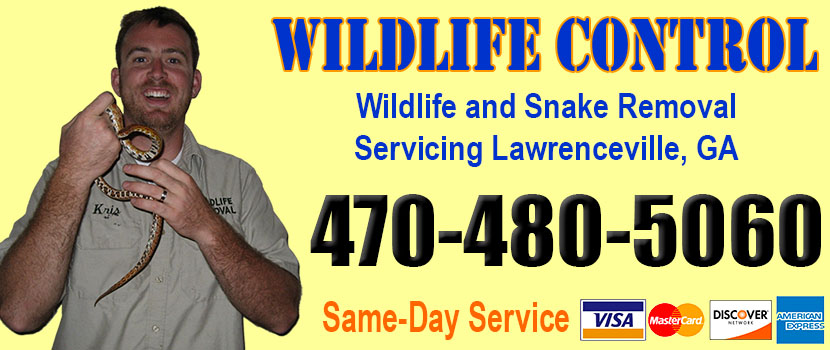
Welcome to lawrencevillesnakes.com! I am David, a snake enthusiast living in Lawrenceville, GA. Many people don't know that Lawrenceville is in fact full of snakes! You just need to know where to find them - they can often be shy and elusive. Some Georgia snake species are more common outside of the city limits, in different parts of Gwinnett County GA, but many types of snakes are indeed common in the more urban parts of Lawrenceville. This guide is meant to help educate you about the beautiful snakes of Lawrenceville, and to help you identify the most common snakes of Lawrenceville, as well as the venomous snakes of Lawrenceville that you should learn to recognize and avoid. If you want more detail, click here for my complete list of ALL snake species in Lawrenceville. Remember the following:
- Most snakes of Lawrenceville are harmless and don't want to encounter you
- Venomous snakes exist but are uncommon in Lawrenceville, Georgia
- Snakes eat rats and mice and are a valuable part of the Georgia ecosystem
- Never kill a snake - if you leave a snake alone, it will leave you alone.
Common Snake Species in Lawrenceville
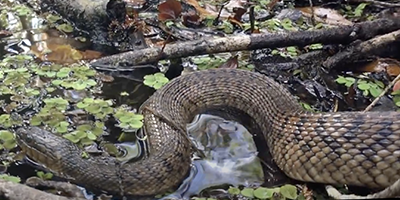 Eastern Green Water Snake:
The green water snake is widely known as the largest water snake in North America reaching up to 30 to 55 inches in length.
As adults, they would generally have a solid greenish to brownish color with a plain whitish belly. In other places, they would also be in a reddish or brown color.
They are found in various locations but prefer to be in vegetation choked still waters like swamps and marshes. Sometimes, they would also be found in lakes, ponds, and slow rivers.
Spending most time in the water, it is said that their diet primarily consists of fishes and amphibians.
Eastern Green Water Snake:
The green water snake is widely known as the largest water snake in North America reaching up to 30 to 55 inches in length.
As adults, they would generally have a solid greenish to brownish color with a plain whitish belly. In other places, they would also be in a reddish or brown color.
They are found in various locations but prefer to be in vegetation choked still waters like swamps and marshes. Sometimes, they would also be found in lakes, ponds, and slow rivers.
Spending most time in the water, it is said that their diet primarily consists of fishes and amphibians.
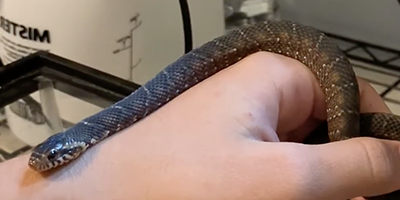 Banded Water Snake:
These heavy-bodied semi-aquatic snakes range in color from light brown to reddish to black with darker crossbands. While they resemble the pattern of copperheads, a banded water snake’s crossbands are wider at the back and narrow on the sides.
They are normally found nearby freshwater habitats. This includes lakes, ponds, rivers, swamps, and the like.
Oftentimes, they are active both during the day and night.
Banded Water Snake:
These heavy-bodied semi-aquatic snakes range in color from light brown to reddish to black with darker crossbands. While they resemble the pattern of copperheads, a banded water snake’s crossbands are wider at the back and narrow on the sides.
They are normally found nearby freshwater habitats. This includes lakes, ponds, rivers, swamps, and the like.
Oftentimes, they are active both during the day and night.
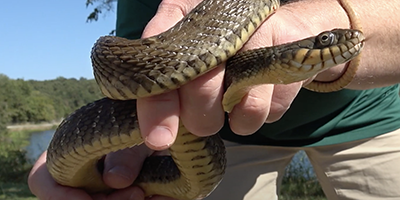 Plain-bellied Water Snake:
The plain-bellied water snake is harmless despite being large in size. They are semi-aquatic, therefore spending more time nearby water.
They often overhang from branches and would drop into the water when they are threatened or alarmed.
Because of their appearance and habitat, they are commonly mistaken for the cottonmouth water moccasin which is venomous.
They take their name from having plain colored bellies such as red, orange-red, or yellow while being brown on top.
Plain-bellied Water Snake:
The plain-bellied water snake is harmless despite being large in size. They are semi-aquatic, therefore spending more time nearby water.
They often overhang from branches and would drop into the water when they are threatened or alarmed.
Because of their appearance and habitat, they are commonly mistaken for the cottonmouth water moccasin which is venomous.
They take their name from having plain colored bellies such as red, orange-red, or yellow while being brown on top.
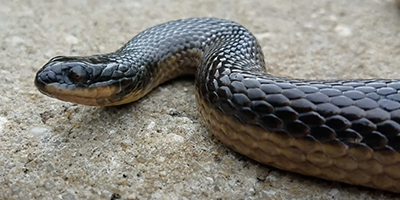 Striped Crayfish Snake:
These snakes are highly aquatic, colored a shiny brown to green with three stripes that run down their body. Their underside is usually yellow or orange with a row of dark spots running down the center of their belly.
They inhabit various aquatic locations such as cypress stands, swamps, roadside ditches, bogs, prairies, and more similar areas.
They are the secretive type and therefore are not seen very frequently than that of other aquatic snakes.
Striped Crayfish Snake:
These snakes are highly aquatic, colored a shiny brown to green with three stripes that run down their body. Their underside is usually yellow or orange with a row of dark spots running down the center of their belly.
They inhabit various aquatic locations such as cypress stands, swamps, roadside ditches, bogs, prairies, and more similar areas.
They are the secretive type and therefore are not seen very frequently than that of other aquatic snakes.
Venomous Snake Species in Lawrenceville
 Copperhead:
A copperhead reaches up to 4 and a half in length but averages at about 3 feet long. Their background color is usually light brown or gray, sometimes ranging from rusty orange colors to pinkish and even nearly black.
They are identifiable through their pattern -which are hourglass-shaped crossbands going across the back to the sides. The wider part is at the sides of the body while the narrower part is along the back.
Commonly, they are found in rocky wooded hillsides with an abundance of logs, rocks, and debris where they can take cover.
They tend to avoid habitats that are open such as fields and other similar places.
Copperhead:
A copperhead reaches up to 4 and a half in length but averages at about 3 feet long. Their background color is usually light brown or gray, sometimes ranging from rusty orange colors to pinkish and even nearly black.
They are identifiable through their pattern -which are hourglass-shaped crossbands going across the back to the sides. The wider part is at the sides of the body while the narrower part is along the back.
Commonly, they are found in rocky wooded hillsides with an abundance of logs, rocks, and debris where they can take cover.
They tend to avoid habitats that are open such as fields and other similar places.
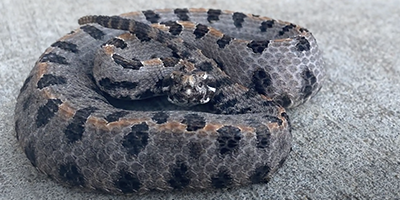 Pygmy Rattlesnake:
Among all the venomous rattlesnakes, the smallest in the family is the pygmy rattlesnake. Reaching a maximum of 31 inches in length but averaging between 16 to 23 inches long.
Their pattern consists of a series of light-edged dark blotches on the back. There would also be one to three rows of dark spots that go along their sides.
Their rattles aren’t as distinct as that of other rattlesnakes. In some cases, they would be lacking a rattle.
They tend to spend most of their time hidden among leaf litter and would be quite hard to spot, mainly because of their colors and patterns. From their hiding places, they are able to attack their unknowing prey.
Pygmy Rattlesnake:
Among all the venomous rattlesnakes, the smallest in the family is the pygmy rattlesnake. Reaching a maximum of 31 inches in length but averaging between 16 to 23 inches long.
Their pattern consists of a series of light-edged dark blotches on the back. There would also be one to three rows of dark spots that go along their sides.
Their rattles aren’t as distinct as that of other rattlesnakes. In some cases, they would be lacking a rattle.
They tend to spend most of their time hidden among leaf litter and would be quite hard to spot, mainly because of their colors and patterns. From their hiding places, they are able to attack their unknowing prey.
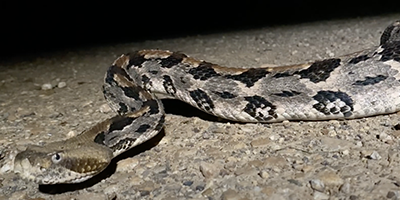 Timber Rattlesnake:
The timber rattlesnake leans more towards the larger size of snakes in the area. They vary in color but have a uniform pattern of chevron-shaped crossbands that cross the body. These patterns would usually be colored brown or black.
They are common in heavily wooded areas. While they can be found in open areas, they would usually choose to reside in these areas if there is a lot of wood.
These snakes are part of the pit viper family, which explains how they search for their prey through the help of the heat-sensitive pits located on each side of the head.
Timber Rattlesnake:
The timber rattlesnake leans more towards the larger size of snakes in the area. They vary in color but have a uniform pattern of chevron-shaped crossbands that cross the body. These patterns would usually be colored brown or black.
They are common in heavily wooded areas. While they can be found in open areas, they would usually choose to reside in these areas if there is a lot of wood.
These snakes are part of the pit viper family, which explains how they search for their prey through the help of the heat-sensitive pits located on each side of the head.
If you're unsure, you can email me a photo of the snake at info@lawrencevillesnakes.com and I will email you back with the snake's species. If you found a snake skin, read my Found a Skin? page, and you can email me a photo of the skin, and I'll identify the snake for you. If you need professional Lawrenceville snake removal help, click my Get Help page, or see the below website sponsor I found, who provides that service.
Remember, the term is not poisonous snakes of Lawrenceville, it's venomous snakes of Lawrenceville. Poison is generally something you eat, and venom is injected into you. That said, dangerous snakes are very rare in Lawrenceville. The few venomous snakes of Gwinnett County are rarely seen. But they are commonly misidentified, so learn about all the snake species of Lawrenceville in order to correctly identify them. These snakes are usually also found in the surrounding towns of Lawrenceville, Duluth, Centerville, Snellville, Norcross, Suwanee, Lilburn, Dacula, Sugar Hill, Grayson, Peachtree Corners, Berkeley Lake, Mountain Park and the surrounding areas.
Read our article about:
Identifying a Shed Snake Skin
lawrencevillesnakes.com domain and hosting costs made possible by the generous support of this sponsor:
